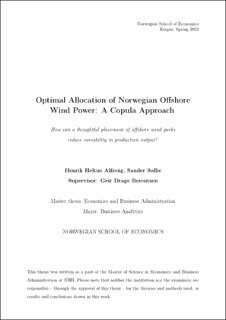Optimal Allocation of Norwegian Offshore Wind Power : A Copula Approach : How can a thoughtful placement of offshore wind parks reduce variability in production output?
Master thesis
Permanent lenke
https://hdl.handle.net/11250/3094350Utgivelsesdato
2023Metadata
Vis full innførselSamlinger
- Master Thesis [4372]
Sammendrag
This thesis investigates how to optimize stable wind production along the coast of Norway.
The research is carried out by studying how well a compound dependency model, consisting
of a time series and copula model, for simulation of wind power data performs compared
to historical data when optimizing a portfolio for wind power production areas. The
weights for the areas in the portfolio are computed so that the areas with the most stable
joint power production are included. The findings of this research will contribute to the
understanding of how effective different optimization approaches for offshore wind park
placements are and provide insights into the selection of optimal areas for offshore wind
power development in Norway.
The study's findings indicate that portfolio optimization performed on simulated data
performs better than on historical data. Consequently, zero and low production values are
reduced, and stability is increased for the portfolio made with simulated data. Moreover,
Value at Risk (VaR) is argued to be a better performance measure for stable wind
production than variance. The portfolio distribution when maximizing VaR is more
left-skewed than the portfolio minimizing variance. Thus, maximizing VaR results in a
higher variance, but less zero and low production values, and a higher average production
which is argued to be more important.
The positive effect of dispersed wind parks regarding stable wind production is evident.
Following the pattern of diminishing correlation as distance increases, the optimal
combination of wind parks includes places throughout the Norwegian coast. All areas are
included in the optimal solution, but the most influential areas which should be prioritized
are Sørlige Nordsjø 2, South of Kristiansand, West of Tromsø, and North of Tanafjorden.
When the criteria for stable wind production is extended to include a penalty factor for
low average production, diversification is partly de-prioritized to include areas with high
average production, among these, more southern areas are included.
